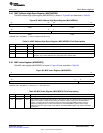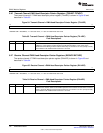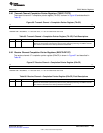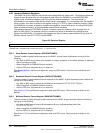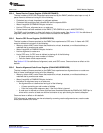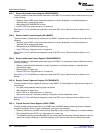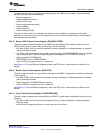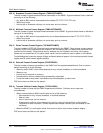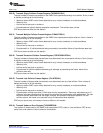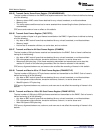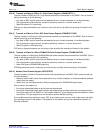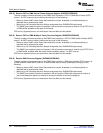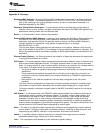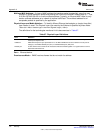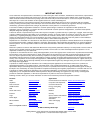
www.ti.com
Appendix A Glossary
Broadcast MAC Address— A special Ethernet MAC address used to send data to all Ethernet devices
on the local network. The broadcast address is FFh-FFh-FFh-FFh-FFh-FFh. The LSB of the first
byte is odd, qualifying it as a group address; however, its value is reserved for broadcast. It is
classified separately by the EMAC.
Descriptor (Packet Buffer Descriptor)— A small memory structure that describes a larger block of
memory in terms of size, location, and state. Descriptors are used by the EMAC and application to
describe the memory buffers that hold Ethernet data.
Device — In this document, device refers to the processor.
Ethernet MAC Address (MAC Address)— A unique 6-byte address that identifies an Ethernet device on
the network. In an Ethernet packet, a MAC address is used twice, first to identify the packet’s
destination, and second to identify the packet’s sender or source. An Ethernet MAC address is
normally specified in hexadecimal, using dashes to separate bytes. For example,
08h-00h-28h-32h-17h-42h.
The first three bytes normally designate the manufacturer of the device. However, when the first
byte of the address is odd (LSB is 1), the address is a group address (broadcast or multicast). The
second bit specifies whether the address is globally or locally administrated (not considered in this
document).
Ethernet Packet (Packet)— An Ethernet packet is the collection of bytes that represents the data portion
of a single Ethernet frame on the wire.
Full Duplex— Full-duplex operation allows simultaneous communication between a pair of stations using
point-to-point media (dedicated channel). Full-duplex operation does not require that transmitters
defer, nor do they monitor or react to receive activity, as there is no contention for a shared medium
in this mode. Full-duplex mode can only be used when all of the following are true:
• The physical medium is capable of supporting simultaneous transmission and reception without
interference.
• There are exactly two stations connected with a full duplex point-to-point link. As there is no
contention for use of a shared medium, the multiple access (that is, CSMA/CD) algorithms are
unnecessary.
• Both stations on the LAN are capable of, and have been configured to use, full-duplex
operation.
The most common configuration envisioned for full-duplex operation consists of a central bridge
(also known as a switch) with a dedicated LAN connecting each bridge port to a single device.
Full-duplex operation constitutes a proper subset of the MAC functionality required for half-duplex
operation.
Half Duplex— In half-duplex mode, the CSMA/CD media access method is the means by which two or
more stations share a common transmission medium. To transmit, a station waits (defers) for a
quiet period on the medium, that is, no other station is transmitting. It then sends the intended
message in bit-serial form. If, after initiating a transmission, the message collides with that of
another station, then each transmitting station intentionally transmits for an additional predefined
period to ensure propagation of the collision throughout the system. The station remains silent for a
random amount of time (backoff) before attempting to transmit again.
Host— The host is an intelligent system resource that configures and manages each communications
control module. The host is responsible for allocating memory, initializing all data structures, and
responding to port (EMAC) interrupts. In this document, host refers to the device.
Jabber— A condition wherein a station transmits for a period of time longer than the maximum
permissible packet length, usually due to a fault condition.
Link— The transmission path between any two instances of generic cabling.
133
SPRUFL5B–April 2011 Glossary
Submit Documentation Feedback
© 2011, Texas Instruments Incorporated



